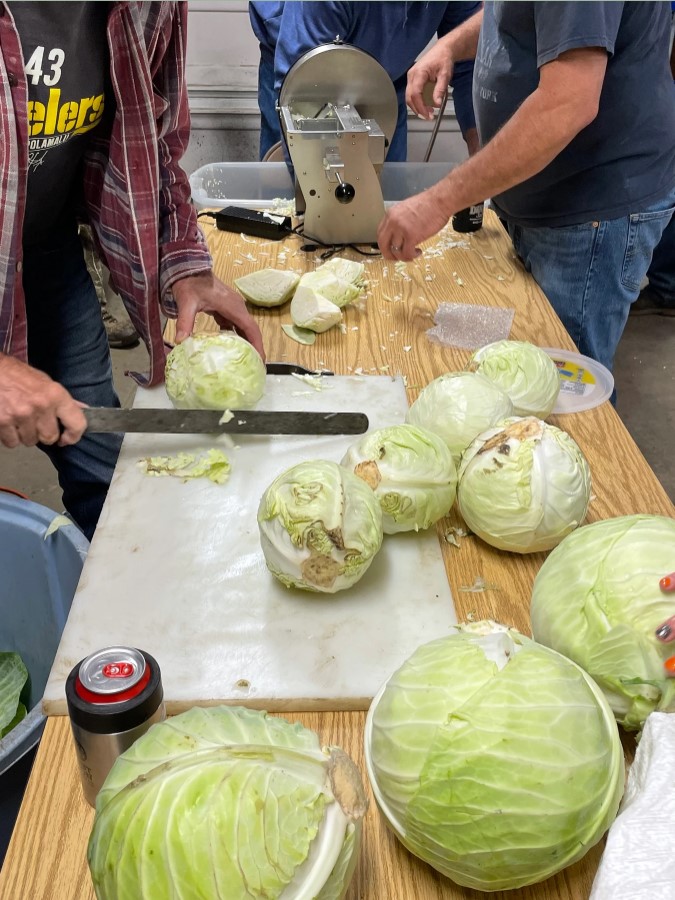Bare-Knuckle Kraut
By Megan Schreiber-Carter
On a frosty, October evening, under a moon close to full, a two-stall garage hosted some high-energy goings-on in the forests of Elk County, PA.
“Stop talkin’ and start cuttin’!” one man barked at his crewmates. Laughter burst out of everyone in the place, including the barker.

While the production line, of family and friends, processed this year’s 350 pounds of cabbage, some of last year’s sauerkraut, cooked with sausage, stayed warm on the wood stove. They’d eat once the work was done.
“How HE got in here, I don’t know,” announced the barker. More laughter, trimming, chopping, shredding, scooping, sprinkling, stomping…. All this, at a rapid pace, while talking over each other and the game on the TV, insulting each other, and belly laughing some more.

Blades, however, were a serious matter.
The knives they handled with great skill, and they took care near the electric shredding blade, which “is a lot easier” than the old, hand shredders. Start to finish, they’d be done in four hours with this machine.
Bandages graced a couple of skinned knuckles. Minor injuries seemed expected and served as yet another source of good-natured abuse, and laughter, among the able crew. The un-skinned appeared eager for counsel from the knuckle-nicked veterans, who gladly gave it, as the task moved along and another generation learned how it’s done.
At the end of the evening, they’d each leave with 50-pound tubs of kraut to ferment, at home, before sharing with more family and friends around New Year.

“Where the hell is he?” barked the same man about a missing cabbage trimmer. Laughter. He continued, “He always disappears about this time—every year!” A louder layer of laughter rippled through the garage.
The barker stepped in as trimmer, filling the breach and maintaining the pace until the last cabbages were stomped, in a tub, between layers of “canning and pickling salt.”
“Stomping,” or tamping-down, mixes in the salt and releases juice from the cabbage.

Next, the mix ferments, in a cool place, under the weight of about 5 gallons of water in a clear, plastic bag. “The weight of the water seals it. The salt and lack of air pickle it.” And, the clear plastic bag lets you see when fermentation is complete—said to be when the bubbling stops. Fermenting takes about 6-to-8-to-9 weeks, depending upon who’s talking.
“Then, you drain the 5 gallons of water.”

Once today’s processing wrapped up, the crew sat, happily, eating the tasty kraut from last year’s batch. Decades-old stories came out about processing 6-12 TONS of cabbage in just a few hours with hand-shredding blades and lots of people who’ve since “quit doing it.”
The crew passed along some good-kraut-making advice—”late cabbage” is the best to use, “the colder it is out, the better,” and “don’t just trim the outer leaves—cut out the cores, which can make the kraut bitter.”
Talk turned to differences of opinion, about such things as the scum that forms on the surface of the mix during fermentation. “The scum has the flavor. I leave it in there.” “No,” says another, “I scrape that off!”
One insisted the sauerkraut can be served, “just fine,” from the tub “until July.” Most laughed at that, advising that the kraut come out of the tub in about eight weeks.
Most agreed that fully fermented sauerkraut may be eaten fresh from the refrigerator for several months. For longer storage, the kraut may be preserved by freezing or glass canning, in portions.

All agreed—you can buy kraut in the store, but “homemade is the best.” It’s “fresher, crunchier. It doesn’t taste like a metal can,” or “taste like nothing,” or “like preservatives.” And, for this crew, it cost $20 per 50 pounds of kraut, cut thicker and processed with nothing but salt, just the way they like it.
Looking forward to New Year.
Out here, Megan
***
Click Here and read Megan’s sauerkraut adventure (with lots more photos) at her website, Megansdesk.net.
About the Author:
Megan Schreiber-Carter is a third-generation native of a storied, old borough in the Pennsylvania Wilds’ Allegheny Mountains.
For decades, she lived and worked along the Potomac River, in D.C.. These days, Megan finds more inspiration in the forests of her “native altitude,” in the place her family’s called “home” for more than 100 years. Megan creates award-winning, multi-media content for audiences and clients, worldwide, including—Discovery Networks, National Geographic, universities, publishers, diplomats, and other individuals and organizations. She has recently begun launching a creative, non-fiction series, called “Megan’s Mostly-True Stories,” as well as a blog, all of which you can find on her website, megansdesk.net.



